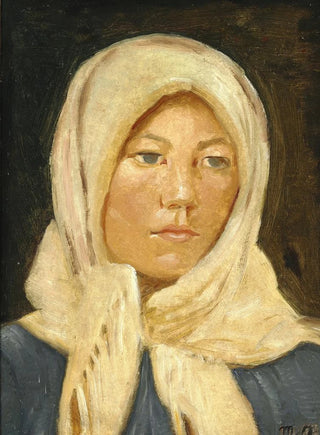Art print | A Young Girl of Skagen with a Turban - Michael Ancher


View from behind

Frame (optional)
In the vast panorama of Nordic art, the artwork "A Young Girl from Skagen with a Turban" by Michael Ancher stands out for its ability to capture an essence that is both intimate and universal. This painting, created at the end of the 19th century, evokes not only the beauty of a female face but also the depth of an era marked by social and cultural changes. Ancher, an eminent member of the Skagen movement, managed to immortalize the spirit of his native region while incorporating influences that transcend geographical boundaries. The art print of this work allows you to immerse yourself in a universe where light and color intertwine to give life to palpable emotions.
Style and uniqueness of the work
Michael Ancher's work is characterized by a vibrant color palette and striking lighting, which highlight the delicate features of the young girl. The turban, the centerpiece of the composition, adds an exotic and mysterious dimension, while emphasizing the originality of the depicted character. The artist's technique, blending realism and impressionism, gives the canvas an atmosphere that is both serene and dynamic. The brushstrokes, precise yet fluid, convey a particular sensitivity to natural light, typical of Skagen artists. Every detail, from the fabric of the turban to the reflections in the young girl's eyes, is carefully observed, creating a visual harmony that invites the viewer to linger on the scene. This work does not merely depict a face; it evokes a story, a culture, and an identity, testifying to the richness of Danish artistic heritage.
The artist and his influence
Michael Ancher, born in 1849, is an emblematic figure of the Skagen school, where he developed a style that is uniquely his own while fitting into a collective tradition. Influenced by contemporaries such as Peder Severin Krøyer and Anna Ancher, he contributed to shaping the Danish artistic landscape of the 19th century. His commitment to representing everyday life, particularly that of fishermen and women of Skagen, testifies to a desire to

Matte finish

View from behind

Frame (optional)
In the vast panorama of Nordic art, the artwork "A Young Girl from Skagen with a Turban" by Michael Ancher stands out for its ability to capture an essence that is both intimate and universal. This painting, created at the end of the 19th century, evokes not only the beauty of a female face but also the depth of an era marked by social and cultural changes. Ancher, an eminent member of the Skagen movement, managed to immortalize the spirit of his native region while incorporating influences that transcend geographical boundaries. The art print of this work allows you to immerse yourself in a universe where light and color intertwine to give life to palpable emotions.
Style and uniqueness of the work
Michael Ancher's work is characterized by a vibrant color palette and striking lighting, which highlight the delicate features of the young girl. The turban, the centerpiece of the composition, adds an exotic and mysterious dimension, while emphasizing the originality of the depicted character. The artist's technique, blending realism and impressionism, gives the canvas an atmosphere that is both serene and dynamic. The brushstrokes, precise yet fluid, convey a particular sensitivity to natural light, typical of Skagen artists. Every detail, from the fabric of the turban to the reflections in the young girl's eyes, is carefully observed, creating a visual harmony that invites the viewer to linger on the scene. This work does not merely depict a face; it evokes a story, a culture, and an identity, testifying to the richness of Danish artistic heritage.
The artist and his influence
Michael Ancher, born in 1849, is an emblematic figure of the Skagen school, where he developed a style that is uniquely his own while fitting into a collective tradition. Influenced by contemporaries such as Peder Severin Krøyer and Anna Ancher, he contributed to shaping the Danish artistic landscape of the 19th century. His commitment to representing everyday life, particularly that of fishermen and women of Skagen, testifies to a desire to






